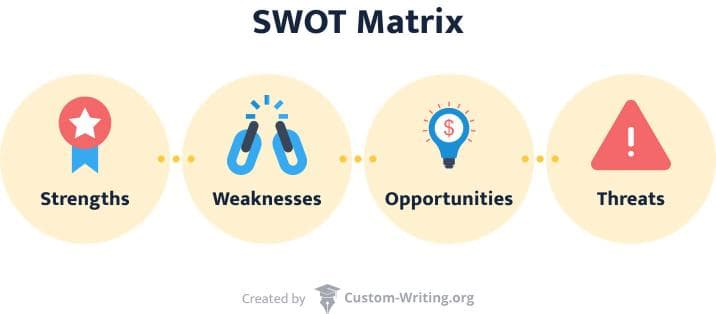SWOT Analysis AI Generator
Try this free SWOT analysis creator to make a beautiful report online. Fill in the blanks, choose the template you like most, and download your customized chart.
⚙️ SWOT Analysis Generator FAQ
- Collect the information on the company’s strengths, weaknesses, opportunities, and threats.
- Enter the data into the respective fields of SWOT Creator, dividing it into points.
- Select the desired design from our list of templates.
- Download the result in the preferred format from SWOT Analysis Creator.
💼 SWOT Analysis: Why Is It Necessary?
SWOT is one of the most convenient tools for business owners to evaluate the efficiency of their business. It is also useful as a component of a feasibility study while creating a business plan. It is not the only way to assess a company’s performance but is the most illustrative and widely used.
SWOT analysis is necessary to see how your company can manage its challenges and define the new objectives to pursue. This approach allows companies to develop an extensive and profound awareness of the factors affecting their business decisions.
If you’re delving into finance or business assignments that require a comprehensive SWOT analysis or any other technical evaluation, expert assistance can be invaluable. Our finance assignment help offers guidance to ensure your papers meet academic and professional standards. Whether you’re tackling complex case studies or conducting detailed financial assessments, our tailored services can make the process smoother and more effective. Let us help you excel in your studies!
📊 What Is the SWOT Matrix?
SWOT matrix consists of 4 components, each starting with the respective letter of the abbreviation. The first two represent the current situation, and the last two stand for the external factors outside the company’s control.

Strengths
Strengths distinguish your company from all the rest. It is what you do exceptionally well and will even do better in the future. But mind that any feature becomes a strength only if it is a clear competitive advantage. For instance, when all the competitors can boast of high-quality products, quality becomes a necessity, not a benefit.
Highly motivated staff, access to low-cost resources, state-of-art manufacturing tools, etc.
Weaknesses
Similar to strengths, weaknesses are the inherent features of your company.
There are 2 types of weaknesses:
- Those you can improve,
- Those you should avoid.
You can also learn a lot from your company’s image in the eyes of its competitors. After all, many people remain blind to their own drawbacks.
Undertrained staff, a large percentage of defective products, and inability to get direct client feedback.
Opportunities
Opportunities are current or expected circumstances outside your organization that can improve its business.
Opportunities are often mistaken for strengths. The main difference is their potential. You should avail of the situation and act quickly to prevent other companies from benefiting from it. Only in this case will it transform into your strength.
New scientific developments, international forums and exhibitions, and changes in government policy.
Threats
Threats comprise the broadest list of events, circumstances, or actions that can harm your organization but have not affected it yet. Besides, unused or incorrectly applied opportunities can turn into threats to your business. They teach the manager to be flexible and proactive.
Organizational problems, conflicts among the management, and technical issues of the company’s online presence.
📑 SWOT Analysis Template
Find below a SWOT template with four lists of questions to ask yourself about the company you are analyzing.

| Strengths | Weaknesses |
|---|---|
|
|
| Opportunities | Threats |
|
|
📄 SWOT Analysis Examples
This section contains several links to A+ essay examples that focus on SWOT analysis of various companies and personalities. We hope that they will inspire you to write your own piece.
-
Walt Disney Company: SWOT Analysis
The essay focuses on SWOT analysis of Walt Disney - a globally recognized entertainment brand that most of the world’s population is familiar with since childhood, thanks to the outstanding cartoons the company has created.
-
SWOT Analysis for Best Buy Company
The paper analyzes Best Buy - an electronic retailer headquartered in Richfield, Minnesota, United States. The company has been operating over the last 50 years, with the employee team reaching 125,000 workers.
-
SWOT Analysis of Škoda Company
This case study focuses on Škoda, a Czech automobile manufacturer established in 1925 and privatized to the German Volkswagen Group.
-
Personal SWOT Analysis to Determine the Career Development Strategy
This paper is an example of using SWOT (strengths, weaknesses, opportunities, and threats) analysis in the personal context; this is a good option for improving one’s abilities and eliminating problems.
Thank you for reading this article! We hope that it was helpful. Note that if you need to formulate a thesis statement for your SWOT essay, you can use our free thesis generator.
❓ SWOT Analysis Maker FAQ
SWOT Analysis Template Creator allows you to enter a company’s strengths, weaknesses, opportunities, and threats into specific fields. Then you can choose the preferred format and download the result in one of the available file extensions for free.
A SWOT analysis chart provides a condensed and informative picture of the company’s current condition and future perspectives. Based on this diagram, a qualified analyst can develop a plan to use the opportunities and eliminate the threats based on the existing strengths and weaknesses.
SWOT helps you identify the areas requiring changes for the company to thrive. It frames the need for change and aligns the vision and goals of a team with the costs and benefits of making them happen.
The time from collecting information to creating a final diagram is personal (depends on your experience) and varies from company to company. Our SWOT template generator will produce a ready-to-use picture in seconds if you have already found the necessary data.
Updated: